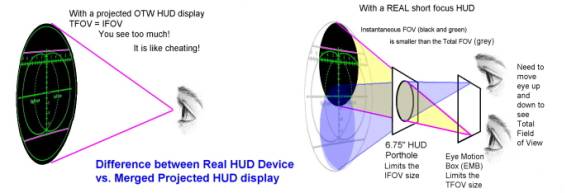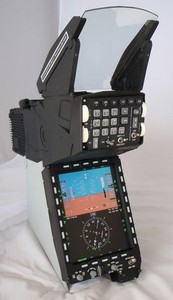Why Use a Short Focus Hud Device?
Why not just use the merged HUD image superimposed on the Out The Window (OTW) scene via projector?
Why would anyone want to pay so much for a HUD Device when simply projecting the HUD symbology on the screen is virtually free!
The answer is: High Fidelity Realism in Training.
Looking through a HUD Device and seeing the virtual display floating off in the distance is significantly different in many ways from seeing the merged display projected on the OTW screen.
It can be important to train pilots to have to look through a curved combiner glass to get high fidelity replication of the real flight experience. There is the glare and flare of the glass itself. There are transmissivity issues. There is the 30% reduction of light due to the beam splitting properties. There is a slight color difference. There is a certain glow to the lines and symbols that cannot be replicated by a projector on screen. These are relatively minor when compared to below.
Most importantly, there are specific constraints that a HUD Device imposes upon the pilot that cannot be simulated by a merged OTW superimposed HUD overlay. The limitations of the HUD Device’s Field of View (FOV) issues will NOT be evident when the display is projected on screen. The PURPOSE of using a HUD Device, is to train the pilot to MASTER these LIMITATIONS.
To understand these issues, we need to understand the concepts of TFOV, IFOV and EMB.
TFOV = Total Field of View
IFOV = Instantaneous Field of View
EMB = Eye Motion Box
When one takes a picture through a porthole on a ship, the picture only captures only part of the entire scene. That is the Instantaneous Field of View (IFOV). To see the ENTIRE landscape, one must move the head to the left and then to the right and then up and down to change the angle on the view.
To make this analogy more accurate, imagine a second window, between the camera and the porthole. The second window will restrict your view of the ENTIRE landscape because your head cannot move as far left, right, up or down before the view is obstructed by the second window. This restricted space is defined as the Eye Motion Box (EMB). As long as you are within the EMB you will have your IFOV. If you move around inside the EMB, your angles will allow you to see more of the landscape up to a certain limit. This extra scenery that you can potentially see by moving the eye side to side and up and down comprises the Total Field of View (TFOV). Outside the box, you will have no view.
 
So you can see that the HUD Device definitely imposes restrictions on the view, and that all the data on the HUD Device is not instantaneously readable. The pilot must learn to move the head around to scan the entire output.
If you choose to project the merged HUD symbology on the screen, you run into the dilemma of having to choose between TFOV which is too much information and not realistic vs. IFOV which has the correct amount of information, but does not have the potential for seeing the peripheral information of the TFOV based on head movements.
The uninitiated might argue that leaving a giant TFOV on the screen that can be seen instantaneously so that pilots do not need to go through all these head gyrations should be considered an advantage. However, that runs counter to the idea of TRAINING. The analogy would be comparing a simulator that did NOT account for gravity mediated bullet dropoff. It would be easier to point and shoot and not account for gravity, but that is NOT real life. The teaching points here are that the pilot needs to calculate for gravity and distance because gravity and distance are immutable facts of life that need to be worked around.
So, if the idea is to TRAIN pilots to WORK AROUND the constraints of a real life HUD, then projection on the OTW screen would provide negative training since it takes out all those teaching points.
|

Fig 2. This diagram shows how the Eye Motion Box EMB limits the Total Field of View TFOV (25 degrees in the F-16 WAC HUD) and the HUD porthole limits the Instantaneous Field of View IFOV (15 degrees diameter). The pilot on the Left has to move to the left to see the extreme right edge of the TFOV screen. He can only see a limited portion of the entire screen at any given time instantaneously (limited by the Porthole). He would have to lean to the Right to see the Left limit of the screen. Once he is outside the EMBox, he will no longer be able to see anything. By moving his head around, he will be able to scan the entire Total 25 degree FOV with his 15 degree IFOV diameter at any given time.
The center pilot simply shows the normal position of the MONOCULAR FOV of the right eye in a one eyed pilot.
The pilot on the right is demonstrating BINOCULAR FOV. Simply because the 2 eyes are approximately 2.5” apart, each eye has a slightly different instantaneous view. When added together, these two eyes create two IFOV circles are set apart from each other by 5 degrees, giving a total of 20 degrees Binocular FOV. |
|
|
